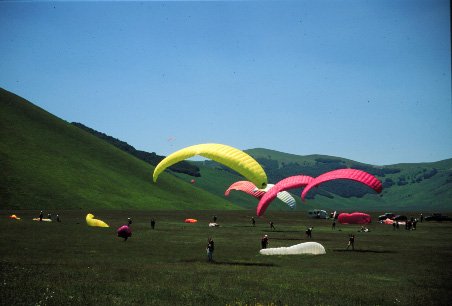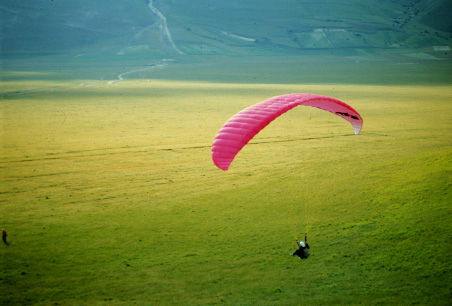
Five days of theory and practical experience, Monday through Friday or over a series of weekends. The initial lessons impart the fundamental concepts and practical theory of paragliding. The hands-on training begins with instruction in ground placement of the sail and harness apparatus in preparation for inflation of the sail. Next, the student acquires the technique of inflating the sail with a running take-off from a low slope. After this technique is mastered the student practices a series of take-offs and landings. At the end of the course, the student undertakes the first high flight, during which time, the student is in constant contact with the instructor. Course package includes: use of equipment, insurance, registration to the sport association of Prodelta club, lessons, textbook, transport to the flight field.
COURSE PROGRESSION:
Familiarity with equipment and ground preparation
Fitting and adjustment of harness
Placement of the sail on the ground
Position of the sail in relation to the wind
Preparing for flight
Inflation of the sail with a running take-off
Practice of landings
Short, straight-line flights with small turns
Landings at higher speeds
Manipulation of the sail for landings
Take-off with a moderate wind
Take-off with a light wind
Take-off with a lateral wind
Conception and execution of a flight plan
Flights of a medium altitude
Comfortable and correct adjustment of the saddle
Turning the paraglider with movement of the body 90degrees and 180 degrees
Use of radio communication
Use and acquaintance with the emergency parachute and its employment
High flight

5 days of theory and practice, from Monday to Friday, or a series of weekends, Saturday and Sunday. Ten high flights with instruction in advanced techniques of flying which will include manipulation of the sail in strong turbulence, simulation of manipulation of the sails in strong turbulence and in spirals. A discussion of meteorological conditions and wind dynamics for the best exploitation of flight in varying conditions will be analyzed. Landings in confined or limited spaces as well as "top landing" ie. landing from a take-off point will be practiced.
COURSE PROGRESSION:
Figure 8 approach to the landing
Figure C approach to the landing
Landing in supported winds
Precision landing
Practice without connection of harness to thighs
Simulation of asymmetrical closing of the sail
Simulation and practice of reverse take-off
Exploration of speeds
Execution of "the ears" and turning
Pitching
Rolling
Execution of asymmetrical closing of the sail
Speed reduction
"Big ears" and/or "B"
Turnings of 360 degrees with an inclination of at least 45 degrees
Sailing in upward dynamics
Upward flight in a thermal
Landing on a slope
Flights in various places